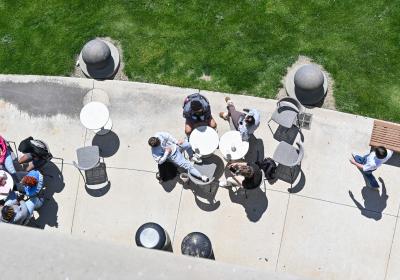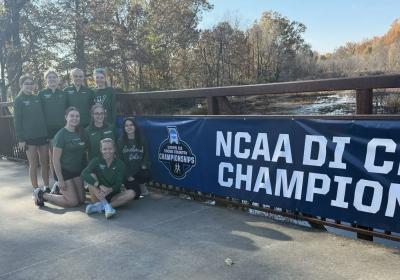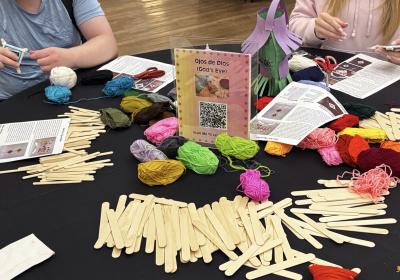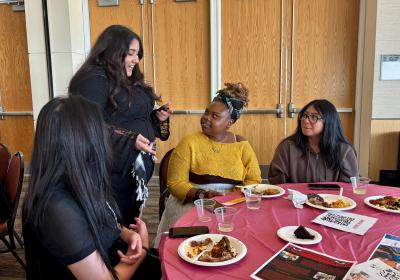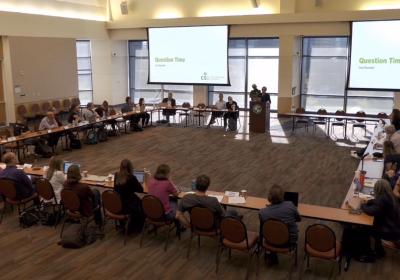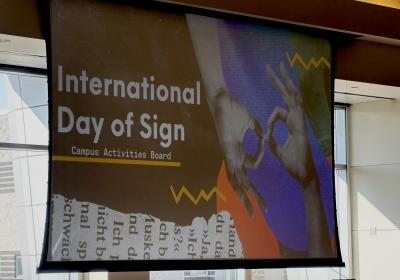
Opinion - Safety last, ignorance first: the CSU motto?
“Hey, you dropped something!”
The gruff call echoed clearly from a block away. I kept my eyes forward, watching the cars speed past ahead of me and beginning to shift my weight from foot to foot impatiently. To my right stood my boyfriend at the time, surveying the traffic and waiting for a clearing. To my left, the owner of the gruff voice hobbled closer.
“Hey man!” the voice came again. “You dropped something!”
The stranger was now crossing the street, quickly approaching us at our curb. The Playhouse Square chandelier glinted nonchalantly above us. I lowered my voice and said to my partner, “He’s coming toward us. We should move.”
My boyfriend looked down at me as if I were the unknown man now less than a hundred feet away. He shrugged my comment off and continued to wait for the crosswalk light to change.
It was broad daylight – 3 p.m. on an August afternoon. We were standing in front of the Euclid Ave. Starbucks. A few couples sat at tables behind us, chatting over drinks. Just that morning, we had both moved into apartments at The Edge on Euclid.
Less than a minute after my warning, I watched as my boyfriend bolted down Euclid Ave., leaving a bloody sidewalk in his wake. I threw myself into the Starbucks behind me, where a barista said, “Yeah, that happens all the time.” She let me stand behind the counter for a few minutes before I had to walk back to my apartment on my own. The strange man had disappeared.
Sixty seconds earlier, he had approached my boyfriend from behind and called for his attention. Upon his confused turn, the man showed him a sheathed machete in one hand and swung with the other. In his other palm was something sharp – a rock or glass, maybe – that cut my partner’s earlobe. I remember panicking and grabbing the stranger’s shoulders to pull him away. Both men stumbled back. My partner ran off.
A split ear and newfound trepidation are not what my boyfriend expected to bring back to his new apartment. It is something that no one ever expects – until it happens to you.
You should not wait until you are injured, robbed or harassed to take protective action. It should be a priority to be aware of prevention tactics in case you find yourself where we were.
If Cleveland State taught incoming students about ways to prevent these types of incidents, my former boyfriend would still have an ear intact. Plenty of students would still have money in their wallets, and even more would feel comfortable walking through the city.
Crime Prevention Class
Incoming freshmen are required to take an introduction to university life course in their first year at Cleveland State. In this course, students are taught how to reach out to their professors and are encouraged to interact among their peers. This class can be skipped for a variety of reasons, mainly if a student has earned college credits previously.
Although this course is a great introduction to college life, it is not the only class that should be required. A course each incoming student should take, no matter their previous college experience, is a crime prevention class.
Since Cleveland State University calls Downtown Cleveland its home, it is also taking on its crime record. According to a report conducted by MoneyGeek, Cleveland ranked as the eighth most dangerous city in the United States in 2023. Merging the sidewalks of Cleveland with the campus of CSU is a risk, especially if the college students walking around are oblivious to the dangers around them.
The risks around Downtown Cleveland have been patched over in small ways on Cleveland State’s campus. You can call a Viking Safety Escort for a lift on a campus if you are feeling unsafe, or find an outdoor blue-light phone station and hit the button to alert CSU Police. Additionally, CSU utilizes an alert system to notify students quickly when a danger is on campus – but not all of them.
CSU Police have also previously held R.A.D., or Rape Agression Defense, classes, but these classes are focused on female-presenting individuals. They are also not required, and happen approximately once a semester. The class for spring 2024 was in January, but there is a chance CSUPD may announce another course. Additionally, A.L.I.C.E. Training classes run every semester through the Office of First Year Experience – the same office in charge of the introduction to university life classes. This is another course not required but should be highly recommended in case of emergencies on campus. The next classes will be held on February 20, 28 and 29 at various times for different schedules.
While these preemptive measures are effective in their own right, Cleveland State is not requiring students to learn how to better protect themselves. In a moment like the one I experienced, blue buttons, a CSU phone or a safety escort would be no help. The piece that was missing here is the knowledge of personal crime prevention.
Crime prevention is not instinctual nor equivalent – everyone has a different background, upbringing and story. Although I was raised to be hyperaware of my surroundings, my boyfriend admitted later that he was completely oblivious to the stranger until he was directly behind us. Many incidents can call blame to this one simple issue – not being aware of what’s happening around you. There are a variety of other useful tricks to learn, such as what to look for, how to present yourself and when to run. These tricks, and many more, could all be contained in a CSU crime prevention class to help students feel safer.
It could be considered irresponsible to be aware of the dangers around campus and then not provide a required course for students to learn useful tips to protect themselves. Through their alert system, Cleveland State notified students around 3-5 times this past fall semester about incidents occurring on campus. Despite this, dangers occur almost every single day on campus, as shown on CSU’s 60-day crime log.
Between criminal endangering, theft and stalking, CSU is aware of the issues and has acknowledged them. Not only has CSU noticed these crimes, but so have faculty. More times than I can count on my hands, I have had professors warn my class to be careful and shared simple ways to stay safe. Rather than using the remaining five minutes of class to tell us about homework, we are being told to keep our phones in our pockets and walk confidently. Professors should not feel the need to teach students how to be safe. There should already be a course in Cleveland State’s curriculum that requires all students to learn these important and valuable skills. Then not only will students feel more comfortable walking around, but the faculty will not have to worry about cautioning their pupils.
This course would only need to take place once a week for one semester. It would need to be taught in-person in order to provide demonstrations of crime prevention techniques and to inspire participation from students. The class could teach self-defense methods and instill beneficial tips to ensure student’s safety around campus. Bringing this class to campus would be extremely beneficial to help students feel safe.
Tips for your Commute
The typical tips that Cleveland State will feed their students are “walk with confidence,” “stay alert,” and “walk with a friend,” as stated in their safety alert emails. While these can be helpful, they do not cover all of the bases and will not entirely ensure your safety. There is a pamphlet of crime prevention tips created in 2016 by Cleveland State Police, but these tips are not shared nor linked alongside the basic ones sent to every student. It is nearly useless to have these tips prepared and then not present them clearly to the people who need them most. Is it possible that Cleveland State only has these tips to excuse itself from any responsibility when someone is harmed on school property?
Some great resources for tips are crime prevention tip books, such as ones by The New York Police Department and Columbia University. I have listed the tips I found most helpful here, in addition to tips that I have learned myself while walking the streets of Cleveland.
General Tips
- Use your voice. If you feel you are in danger, scream. Attackers can be thrown off easily by cries for help – do not bite your tongue because you don’t want to feel embarrassed.
- Carry a whistle and use it if you believe you are in danger.
- Keep a fake wallet to stuff with minimal cash and expired cards. If someone tries to mug you, take this wallet out, throw it and run the opposite way.
- If you have a weapon, keep it in your hand and hidden in your bag, pocket or jacket. Your defense has no purpose if it is out of reach. You will not think quick enough to grab it when it comes down to it.
- Always be listening and looking around you. You should be aware of who is across the street, the noises behind you and the cars driving at you.
- Utilize a zig-zag pattern. Gazelles utilize this tactic to outrun cheetahs, and you can use it to shake someone who’s following you. Cross the street and cut through buildings to quickly hop through different blocks. Don’t ever stand still and wait for cars – go a different way or run across as soon as there is a clearing. If you’re lucky, the traffic will stop your stalker and will give you time to get to the next block.
Walking
- Utilize shop windows to check your reflection and see if anyone is following you.
- If you think someone is talking/calling out to you, they are. Quicken your pace and avoid eye contact.
- If you think someone is following you, it’s time to vlog. Open your camera, Snapchat or Instagram and begin to record yourself in selfie mode. Hold the phone high so you can record what is behind you as well as yourself. Talk aloud about plans, an inconvenience or an assignment you have upcoming.
- Another option is to call someone on the phone or fake it. Talk about meeting up with them or the class you are heading to – “I got stuck in traffic but I’ll be there in a minute!”
- If you believe a car is following you, turn and run the opposite direction that they are driving.
- Plan out escape routes wherever you go. Take note of emergency exits and shortcuts. Utilize alleyways to skip through streets and cut behind buildings. Hide in shops until you feel you are safe.
- Pay attention to stranger’s hands. If you see someone reach into their pocket or jacket, plan to run or yell for help.
- Know where Cleveland State and Cleveland police stations are. Run to either of these buildings if you feel you are in danger.
Driving
- If someone approaches your car while on foot, keep your windows up and do not acknowledge them. Make a plan to escape if necessary and keep the person in your peripherals.
- If you believe someone is following you, take four consecutive left or right turns to complete a circle. If they are still behind you, they are following you.
- Know where the police station is both on campus and in Cleveland. If you feel someone is following you, drive to the closest option immediately.
- Unlock your car doors only once your hand is on the door handle and relock the doors as soon as the door is shut behind you.
- Survey the outside of your car before entering (including underneath it) and glance over everything once inside.
- If you choose to have a defensive weapon in your car, ensure it is in an easy to reach spot. In the event you will have to use it, you will only have a second to reach in and grab it.
Defensive Weapons
- Carrying an item on you to use in case of emergencies is a good idea. This can be in the form of pepper spray, since this is legal on campus – but you can get thrifty with it. A Stanley cup can deliver a tough blow and a pen could seriously mess up someone’s vision. Carry a whistle and use it if you feel threatened.
- Beware of the consequences of carrying a potentially dangerous item on you. While a stun gun is illegal on campus, you can still bring it with you around Cleveland or leave it in your car. According to Ohio law, weapons like stun guns are legal ONLY if you are using it with the strict intent of self-defense. In addition, the law is extremely blurry since there is a fine line between a deadly weapon and one that is not. Despite this, Section 2923.12 of the Ohio Revised Code claims an affirmative defense is if “the weapon was carried or kept ready at hand by the actor for defensive purposes while the actor was engaged in a lawful activity and had reasonable cause to fear a criminal attack upon the actor, a member of the actor's family, or the actor's home, such as would justify a prudent person in going armed.” This is also listed in Cleveland’s Code of Ordinances, Section 627.02. In other words, if you are traveling around the streets of Cleveland and feel you are in danger, you can use a weapon and have probable defense if brought to court.
- If you are unsure about carrying certain defensive weapons, call the Cleveland Police’s non-emergency line for any questions on regulations.
Conclusion
The list above could go on forever. There are also many self-defense methods that can only be taught in-person. Without a crime prevention class on campus, many students walk around with no knowledge of how to protect themselves or are oblivious to dangers around them. Many CSU students have faced a fate similar to the one my ex-boyfriend went through – one that could have been prevented. If Cleveland State does not change and continues to be neglectful, hundreds more students will be assaulted.
Outside of Cleveland State University, there are many options to learn what they will not teach you. Krav Cleveland educates participants on a variety of self-defense methods with a focus on Krav Maga. You can learn kickboxing at Riverview Martial Arts and Fitness in Rocky River to help protect yourself. At Adventure Martial Arts in Parma, you can enroll in a reality-based self-defense class that includes a variety of defensive methods for different scenarios.











